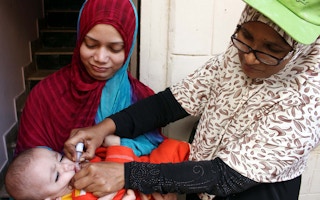For most people, the choice between a life-threatening disease and a lifetime of crippling debt is no choice at all. Yet every year, hundreds of millions of people around the world are forced to make it, owing to the prohibitive cost of medical treatment. And, paradoxically, the hardest-hit people are not those with the largest medical bills, but rather those living in the poorest parts of the world.
To continue reading, subscribe to Eco‑Business.
There's something for everyone. We offer a range of subscription plans.
- Access our stories and receive our Insights Weekly newsletter with the free EB Member plan.
- Unlock unlimited access to our content and archive with EB Circle.
- Publish your content with EB Premium.
Although countries like the United States have notoriously high treatment costs, with medical debt being one of the leading causes of personal bankruptcy, people living in poor countries actually spend more on health care costs relative to their income.
And, because medical insurance is unavailable or too expensive, and because bankruptcy protection is not usually an option, too often they and their families end up being pushed into poverty.
But this tragedy – befalling some of the world’s most vulnerable people – could in many cases be entirely avoided. A new study, published in February in the journal Health Affairs, suggests that there is another option: in many cases, the medical bills can be preempted by prevention, through the widespread and affordable use of vaccines.
We already know that vaccines are one of the most cost-effective ways to prevent disease and death, and the new study provides additional supporting evidence. By modeling the health and economic impact of childhood vaccines for ten diseases in 41 of the poorest countries, the researchers estimate that from 2016 to 2030, these vaccines will prevent 36 million deaths. But their analysis found something else: during the same period, vaccination will also prevent 24 million people from falling into poverty because of the cost of medical treatment.
The World Bank defines “poverty” as household income of less than US$ 1.90 a day. According to the World Health Organization (WHO), health-care costs push as many as 100 million people below this line every year, with 150 million others facing “catastrophic health-care costs,” defined as healthcare spending that consumes 40% of the household budget after basic needs have been met.
All of this highlights the important role vaccination has to play in helping to reduce poverty. The fact that the study found that the greatest benefits of vaccination were among the poorest suggests not only that poorer people are more vulnerable and have a higher risk of developing preventable diseases, but also that the impact on their lives is potentially greater.
For the governments of low-income countries, this is an opportunity, because it shows what they could achieve in terms of improving health equity and reducing poverty by targeting higher vaccination rates in poorer and more marginalized communities. Moreover, by making affordable, quality health care available to everyone, regardless of their income, governments can take an important step toward universal health-care coverage (UHC).
That is because national immunization programs can act as a platform upon which to build a primary-care system. With childhood immunization come supply chains, cold storage, trained health-care staff, medical record keeping, data monitoring, disease surveillance, and much more.
So, when a community gets access to childhood immunization, it is often not long before it also gets access to other services, such as neonatal and maternal care, nutritional supplements, malaria prevention measures, and sexual and reproductive health and education.
In addition to this, immunization programs provide immense reach. Thanks to global health organizations like the WHO, UNICEF and Gavi, the Vaccine Alliance, vaccination is already one of the most widely available health interventions ever.
With 80 per cent of the world’s poorest children now getting access to routine immunization – meaning three shots of a diphtheria-tetanus-pertussis-containing vaccine – we already have a health platform upon which to build UHC, even in the most challenging of countries.
And now, as this new study implies, immunization has an additional, indirect role to play. In the absence of a government-backed national health service or affordable health insurance, routine immunization has a profound financial impact, by saving millions of people from needing health care in the first place, through disease prevention.
This study builds on a growing body of evidence that vaccines not only save lives, but also build economies. Previous studies have estimated that every dollar invested in vaccines saves $16 in terms of health-care costs, lost wages, and lost productivity due to illness, or $44 if the broader benefits of people living longer, healthier lives are taken into account.
What this new study now shows, however, is the tangible impact this has on people’s lives. Over the next decade and a half, vaccines will save millions of families from the grinding misery of extreme poverty. We now have yet another reason to work hard to realize the enormous potential of immunization.
Seth Berkley is CEO of Gavi, the Vaccine Alliance.
Copyright: Project Syndicate, 2018.
www.project-syndicate.org










